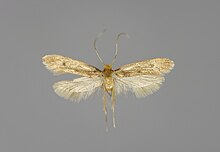Tinea pellionella
| Case-bearing clothes moth | |
|---|---|

| |
| Case with pupal skin (above) Adult moth (below) | |

| |
| Museum specimen | |
| Scientific classification | |
| Domain: | Eukaryota |
| Kingdom: | Animalia |
| Phylum: | Arthropoda |
| Class: | Insecta |
| Order: | Lepidoptera |
| Family: | Tineidae |
| Genus: | Tinea |
| Species: | T. pellionella
|
| Binomial name | |
| Tinea pellionella | |
| Synonyms | |
| |
Tinea pellionella, the case-bearing clothes moth, is a species of tineoid moth in the family Tineidae, the fungus moths. This species has a cosmopolitan distribution, occurring nearly worldwide.[1]
Taxonomy
Being a widespread species and often affiliated with humans, T. pellionella was among the first moths to be scientifically described in the modern sense. At that time most moths were included in a single genus "Phalaena", but Tinea was already recognized as a distinct subgenus. Some later researchers who studied this moth erroneously believed they had discovered populations formerly unknown to science and described them as new species, but today these are all included within T. pellionella. Obsolete scientific names for this moth thus may be encountered in the literature, and include:[2]
- Phalaena (Tinea) pellionella Linnaeus, 1758
- Phalaena zoolegella Scopoli, 1763
- Tinea demiurga Meyrick, 1920
- Tinea gerasimovi Zagulajev, 1978
- Tinea pelliomella (lapsus)
It is the
Another common name is "bagworm" due to the case that their larvae carry around, but not to be confused with the


Description
It is silvery grey to shiny light brown in color, with dark grayish hairs on the top of its head.
Biology
It is
Control measures for the case-bearing clothes moth are similar to those for the
References
- ISSN 0007-4853.
- ^ "The Tineidae Database at the Natural History Museum". Natural History Museum. 2016-03-03. Archived from the original on 2016-03-03. Retrieved 2024-04-03.
- doi:10.5519/s93616qw.
- ^ "Australian Faunal Directory: Species Tinea pellionella Linnaeus, 1758". web.archive.org. Australian Government Department of the Environment. 2012-02-27. Archived from the original on 2015-09-24. Retrieved 2015-09-24.
- ^ "Taxon Details - Tinea pellionella Linnaeus 1758". Fauna Europaea. 2011-01-27. Archived from the original on 2012-10-18. Retrieved 2012-10-18.
- ^ "Tinea pellionella | insectslimited". Archived from the original on 2013-12-03. Retrieved 2013-09-08.
- ^ a b "Case-bearing Clothes Moth Adult | UKmoths". ukmoths.org.uk. Retrieved 2024-04-03.
- ^ Grabe, Albert (1942). "Eigenartige Geschmacksrichtungen bei Kleinschmetterlingsraupen" [Strange tastes among micromoth caterpillars] (PDF). Zeitschrift des Wiener Entomologen-Vereins (in German). 27: 105–109.
- Gaedike, Reinhard (2019). Tineidae. Microlepidoptera of Europe. Leiden: Brill. ISBN 978-90-04-38750-8.
- Petersen, Günther (1957-11-30). "Die Genitalien der paläarktischen Tineiden (Lepidoptera: Tineidae)". Beiträge zur Entomologie = Contributions to Entomology (in German). 7 (5–6): 557–595. ISSN 2511-6428.
